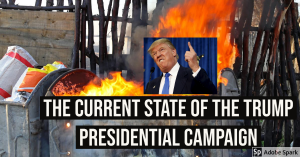Two-thirds is the majority needed in order to veto a law that the President will not sign. It also represented a more-than significant bloc of people for any group, opinion, or matter, regardless of the situation. That said, it is of interest that during an election year, in a time of national crisis, when presidents usually do very well and are able to harness the instability as a way to demonstrate their leadership, what should be an opportunity for Trump to demonstrate his prowess as a leader has become a failure where Trump has according to ABC News a two-thirds majority of the country in disagreement with him over his handling of the COVID-19 coronavirus outbreak.
President Donald Trump is facing broad disapproval for his management of the two major crises gripping the nation, with two-thirds of Americans giving him low marks for both his response to the coronavirus pandemic and his handling of race relations, according to a new ABC News/Ipsos poll released Friday.
Evaluation of Trump’s oversight of the COVID-19 crisis reached a new low since ABC News/Ipsos began surveying on the coronavirus in March, with 67% disapproving of his efforts. One-third of the country approves of the president’s oversight of the pandemic.
Over nearly four months of polling, Trump’s approval has mostly held steady, except for one week in mid-March, when it spiked above 50%. In the last month, Trump’s approval dipped to a range between the high 30s and low 40s, as the U.S. saw a resurgence of coronavirus cases, particularly across the south and west.
In the newest poll, which was conducted by Ipsos in partnership with ABC News using Ipsos’ Knowledge Panel, Trump’s approval rating on his job dealing with the coronavirus dropped another rung, driven by plunging support among independents and even waning support among Republicans. Democrats have always been highly skeptical.
Trump’s approval among independents lands at 26% in the survey, a sharp drop from 40% in mid-June, the last time the question was asked. Trump’s disapproval among independents has risen to 73%, up from 59% in the June poll.
Within his own party, Republicans are less inclined to back him in the newest poll, with only 78% approving of the president’s handling of the coronavirus, compared to 90% in mid-June. His disapproval of 22% in the new poll is a more than two-fold increase from last month.
In a variety of demographic groups, there are clear and consistent shifts in support away from the president.
Men (66%) and women (67%), in near equal measure, disapprove of the president’s coronavirus response, which represents a double-digit increase among men since the June poll, when 54% disapproved.
Even white Americans without a college degree, considered to be a core constituency of Trump’s base, are split in their approval of the president’s handling, with 50% disapproving and 49% approving, compared to 42% disapproving and 57% approving in that last poll.
The newest numbers come as Trump continues to downplay the threat posed by the virus, even as confirmed cases climb. (source)
These numbers are very bad for Trump, and he knows it.
This is not really about the virus, but rather the complete chaos that has been his administration. While it is true that division and racism have benefited Trump’s campaign for a time, it seems to be yielding negative returns at this point. People don’t want racial tension or frustration- they want to live in a society that is somewhat normal, and not completely destabilized by constant tension with their neighbors because contrary to the narrative being pushed, most people are not racist, and the constant talk of racism only serves to potentially engender racism where it is not.
The biggest problem that Trump faces is in “battleground states”, which more have emerged as migration- not of “illegals”, but of white, non-hispanic American-born citizens from “Democrat strongholds” -continues throughout the country. States such as Arizona, Georgia, and North Carolina have become what Florida was two decades ago and Pennsylvania ten years ago, the latter two of which are barely in the grip of Republican control. In total there are nine states that are considered “battlegrounds” (Arizona, Florida, Georgia, Michigan, North Carolina, Ohio, Pennsylvania, Virginia, and Wisconsin) and of which Trump has to win a majority in order to take the White House again. This does not even consider the situation in Texas, which due to the same demographic shifts is not yet, but likely will become a battleground state by the next election.
Now it is true that Trump does have advantages over Biden in that (a) he is an incumbent (they always have the advantage over a contender regardless of political race, (b) Biden is just awful because aside from his unclear platform he shows clear signs of what appears to be dementia or another form of physiological or cognitive decline, and (c) there may still be something enough left of a base in key areas to win an election under the current circumstances. Nevertheless, looking at the history of past races such as those of Bush I in 1992 and Carter in 1980, Trump is in real trouble. If he does win, it will be interesting to see how the numbers work out, because as I have noted, at this point, it may take election-year 2000 tier nonsense to ensure his victory, and knowing that Trump has already well defined his presidency by all kinds of nonsense, at this point there is nothing which is not potentially out of the question.



